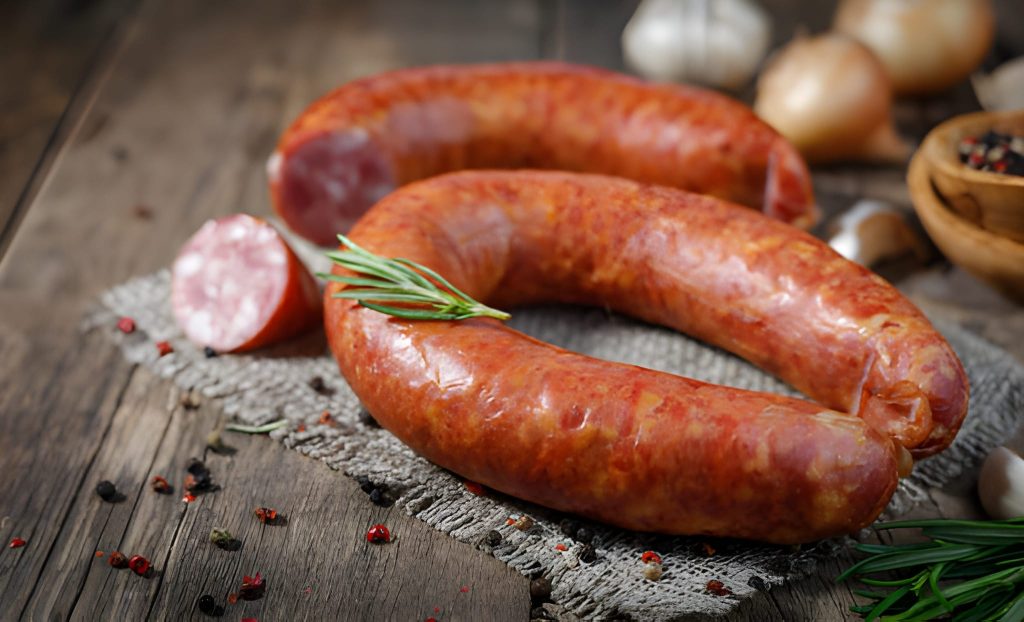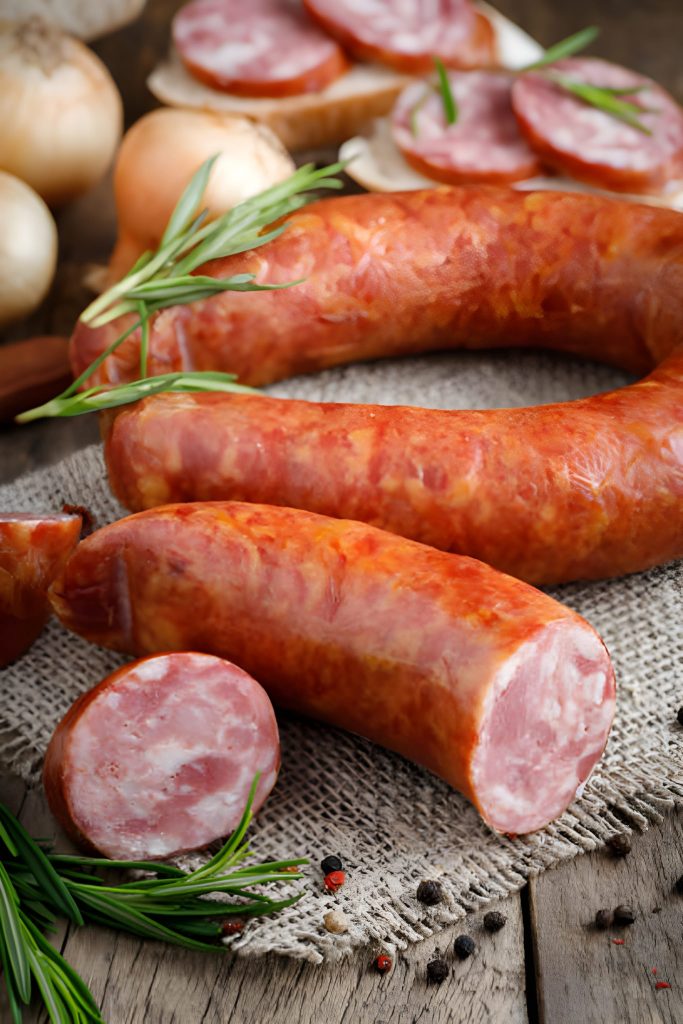Hungarian Sausage Recipe
A masterpiece of smoky aroma, deep paprika color, and old-world craftsmanship, Hungarian Sausage is the kind of recipe that captures the heart of traditional European charcuterie. With its perfect balance of spice, fat, and texture, this sausage is ideal for grilling, pan-frying, or slicing cold on a charcuterie board. Every bite carries the warmth of paprika, the sweetness of garlic, and the earthy whisper of caraway—a true expression of comfort and heritage.

Ingredient Breakdown
The foundation of a great sausage begins with balance. Pork butt provides the rich, meaty structure, while pork belly or back fat ensures juiciness and a tender bite. The fat-to-meat ratio must be just right to achieve a smooth, moist texture without greasiness.
Paprika is the signature of Hungarian sausage—both sweet and hot varieties work together to create the sausage’s vibrant hue and bold, smoky depth. The combination of these two types of paprika gives the sausage its unique color and layered spice. Cure #1, combined with kosher salt, not only enhances the color but also ensures safe curing and long-lasting flavor.
Caraway seeds, freshly ground, infuse the sausage with a nutty, slightly citrus note that harmonizes with the sweetness of garlic. Black pepper adds gentle heat, while a touch of sugar rounds out the flavor profile. Finally, ice-cold water helps emulsify the mixture, giving the sausage its characteristic smoothness and cohesion once cooked or smoked.
Step-by-Step Preparation Guide
The process of creating Hungarian sausage is as much about precision as it is about patience. Begin with properly chilled ingredients—cool meat grinds cleaner and prevents smearing of the fat. Cut the pork butt and belly into even cubes and coat them thoroughly with salt and Cure #1. This initial curing stage, lasting about 24 hours, allows the meat to firm up and develop a base flavor before seasoning.
Once chilled, grind the meat and fat through a medium plate or chop by hand for a rustic finish. Combine the ground mixture with all the seasonings—paprika, garlic, caraway, sugar, and pepper—and pour in the ice-cold water. Mix vigorously by hand until the meat becomes sticky and elastic. This step is crucial, as it ensures the sausage holds together during cooking.
Prepare your hog casings by rinsing them well and soaking them in cool water to remove excess salt. Carefully stuff the meat mixture into the casings, forming even lengths about one foot long. Twist them into rings and prick any air pockets with a sterile needle to avoid splitting during smoking.
Hang the sausages in a cool space overnight to dry and firm. The following day, dry them in a smoker at low heat before applying smoke. Gradually build the flavor by smoking at 130°F for several hours until the casings take on a rich golden-brown tone. Use hardwoods such as oak, beech, cherry, or pecan for a balanced, aromatic smoke.
When the desired color is achieved, gently poach the sausages in hot water at 161°F–165°F until the internal temperature reaches 154°F–158°F. Alternatively, bake in a convection oven with a water pan to mimic steam, or slowly finish in the smoker with careful temperature control. Once cooked, chill the sausages immediately in an ice bath, then dry them thoroughly.
For those seeking deeper flavor, hang the sausages for 5–7 days in a curing space at 55°F with controlled humidity. This drying period enhances the flavor intensity and gives the sausage a firmer, more complex texture.

Recipe Tips & Frequently Asked Questions
Choosing the right pork cuts for optimal fat distribution and juiciness:
Select pork butt with visible marbling and balance it with pork belly for a creamy, moist texture.
The importance of precise temperature control during curing, smoking, and poaching:
Monitor with a meat thermometer—steady, low temperatures preserve texture and flavor without overcooking.
Recommended wood types for authentic smoky aroma:
Hungarian sausage pairs beautifully with mild hardwoods such as oak, cherry, or beech, which provide subtle sweetness without bitterness.
How to maintain sausage shape and prevent bursting:
Prick air pockets before cooking and avoid rapid temperature changes during poaching or smoking.
Long-term storage and flavor-enhancing curing methods:
Store cooked sausages in the refrigerator for up to two weeks or vacuum-seal and freeze for several months. Drying or curing adds depth and extends shelf life.
Can this sausage be made without a smoker?
Yes—oven-bake with a pan of hot water for humidity, or use liquid smoke for flavor.
How long can Hungarian sausage be stored?
Properly refrigerated, it lasts 1–2 weeks; dried or vacuum-sealed versions can last several months.
Can I use beef or poultry instead of pork?
Yes, though pork remains traditional. If substituting, ensure enough fat (about 25%) for moisture.
What’s the purpose of Cure #1, and can it be omitted?
Cure #1 preserves color, prevents bacterial growth, and enhances flavor—omit only if cooking immediately and skipping the smoking stage.
How do I know when the sausage is fully cooked and safe to eat?
Use a thermometer—an internal temperature of 154°F–158°F guarantees safety and optimal texture.
Creative Variations
The base recipe opens the door to countless variations. Adjust the spice ratio to create a milder or hotter sausage—more hot paprika or chili flakes bring extra heat. Mustard seeds or a hint of nutmeg can introduce subtle complexity. For a rustic version, shape the mixture into patties or small links and grill them fresh. Experimenting with different wood types—like applewood for sweetness or hickory for intensity—adds unique regional flair.
What to Serve With This Recipe
Hungarian sausage is wonderfully versatile and pairs beautifully with both traditional and modern sides. Serve it with sauerkraut or braised cabbage for a classic Eastern European meal, or alongside creamy mashed potatoes and buttered noodles for hearty comfort. Crusty rye bread or fresh baguettes make perfect companions for soaking up the smoky juices.
For condiments, opt for sharp Dijon mustard, tangy horseradish, or pickled vegetables to cut through the richness. A glass of dark lager or a robust red wine complements the paprika’s depth, while Hungary’s traditional fruit brandy, pálinka, adds a celebratory touch. On a charcuterie board, sliced Hungarian sausage stands out with cheeses, olives, and cured meats—ideal for festive gatherings.
Hungarian Sausage is a true labor of love—a recipe that rewards patience with rich color, full-bodied flavor, and a texture that melts with every bite. Whether smoked, grilled, or pan-fried, it captures the rustic warmth of Central European cuisine in its most authentic form. With its bold paprika hues and irresistible smokiness, this handcrafted sausage embodies the spirit of traditional comfort food, perfect for sharing around any table.

Ingredients
4 1/2 lbs pork butt
1/2 lb pork belly or back fat
1 3/4 tbsp kosher salt
1 tsp Cure #1 (level)
6 1/2 tbsp sweet paprika
3 tbsp hot paprika
3 tsp ground caraway seeds
7 garlic cloves, pressed
2 1/2 tsp freshly ground black pepper
1 tsp sugar
1 cup ice-cold water
Instructions
Begin by cutting the pork butt and pork belly (or back fat) into roughly 2-inch (5–6 cm) cubes. Combine the meat with kosher salt and Cure #1, ensuring each piece is evenly coated. Transfer the mixture to a covered container and refrigerate for 24 hours to allow the curing process to begin and the flavors to deepen.
After chilling, partially freeze the meat for about 20 minutes—this makes grinding easier and cleaner. Grind the meat and fat using a medium plate (around 1/4 inch or 6 mm). Alternatively, you can finely chop both by hand for a more rustic texture.
Place the ground meat in a large bowl and add all remaining seasonings: sweet paprika, hot paprika, ground caraway, black pepper, pressed garlic, and sugar. Pour in the ice-cold water and mix thoroughly by hand or with a sturdy spoon. Continue mixing until the meat develops a sticky, cohesive texture—this ensures the sausage binds properly.
Prepare hog casings (28–32 mm in diameter) by rinsing them under cool water to remove excess salt. Stuff the meat mixture tightly into the casings, forming links about one foot long. Twist or tie them into rings as desired. Pierce any visible air pockets gently with a sterilized needle to prevent bursting during cooking.
Hang the sausages to rest overnight in a cold, well-ventilated space between 33°F and 38°F, such as an unheated garage in winter or a refrigerator. The goal is to firm up the texture without freezing them.
When ready to smoke, first dry the sausages in a smoker at 110°F–130°F for about 1 hour without smoke until their surfaces are completely dry to the touch. Once dried, begin smoking at approximately 130°F for 2 to 4 hours or until the casings turn a rich brown hue. Wood types such as oak, beech, cherry, hickory, or pecan impart a balanced, smoky aroma ideal for Hungarian-style sausage.
After smoking, poach the sausages in hot water maintained at 161°F–165°F for 25–35 minutes, or until the internal temperature reaches 154°F–158°F. Alternatively, bake them in a convection oven with a pan of hot water below at 175°F for about 30–50 minutes, until the same internal temperature is achieved.
If you prefer to finish them in the smoker, gradually raise the smoker temperature through 165°F, 175°F, and up to 195°F, maintaining a steady increase. This traditional method requires patience and attention to humidity but produces a deeper, more robust flavor.
Once fully cooked, immediately cool the sausages in an ice bath or rinse with cold water to halt the cooking process. Pat them dry with paper towels, or hang them in a cool, well-ventilated room to dry naturally.
For added depth and longer shelf life, hang the sausages in a cool curing chamber or room for 5–7 days at around 55°F with 75% relative humidity. This optional drying stage concentrates the flavor and slightly firms the texture.
Store the finished sausages in the refrigerator, ready to slice, grill, or savor as a traditional Hungarian delicacy bursting with rich paprika warmth and smoky undertones.

Hungarian Sausage Recipe
Ingredients
- 4 1/2 lbs pork butt
- 1/2 lb pork belly or back fat
- 1 3/4 tbsp kosher salt
- 1 tsp Cure #1 level
- 6 1/2 tbsp sweet paprika
- 3 tbsp hot paprika
- 3 tsp ground caraway seeds
- 7 garlic cloves pressed
- 2 1/2 tsp freshly ground black pepper
- 1 tsp sugar
- 1 cup ice-cold water
Instructions
- Begin by cutting the pork butt and pork belly (or back fat) into roughly 2-inch (5–6 cm) cubes. Combine the meat with kosher salt and Cure #1, ensuring each piece is evenly coated. Transfer the mixture to a covered container and refrigerate for 24 hours to allow the curing process to begin and the flavors to deepen.
- After chilling, partially freeze the meat for about 20 minutes—this makes grinding easier and cleaner. Grind the meat and fat using a medium plate (around 1/4 inch or 6 mm). Alternatively, you can finely chop both by hand for a more rustic texture.
- Place the ground meat in a large bowl and add all remaining seasonings: sweet paprika, hot paprika, ground caraway, black pepper, pressed garlic, and sugar. Pour in the ice-cold water and mix thoroughly by hand or with a sturdy spoon. Continue mixing until the meat develops a sticky, cohesive texture—this ensures the sausage binds properly.
- Prepare hog casings (28–32 mm in diameter) by rinsing them under cool water to remove excess salt. Stuff the meat mixture tightly into the casings, forming links about one foot long. Twist or tie them into rings as desired. Pierce any visible air pockets gently with a sterilized needle to prevent bursting during cooking.
- Hang the sausages to rest overnight in a cold, well-ventilated space between 33°F and 38°F, such as an unheated garage in winter or a refrigerator. The goal is to firm up the texture without freezing them.
- When ready to smoke, first dry the sausages in a smoker at 110°F–130°F for about 1 hour without smoke until their surfaces are completely dry to the touch. Once dried, begin smoking at approximately 130°F for 2 to 4 hours or until the casings turn a rich brown hue. Wood types such as oak, beech, cherry, hickory, or pecan impart a balanced, smoky aroma ideal for Hungarian-style sausage.
- After smoking, poach the sausages in hot water maintained at 161°F–165°F for 25–35 minutes, or until the internal temperature reaches 154°F–158°F. Alternatively, bake them in a convection oven with a pan of hot water below at 175°F for about 30–50 minutes, until the same internal temperature is achieved.
- If you prefer to finish them in the smoker, gradually raise the smoker temperature through 165°F, 175°F, and up to 195°F, maintaining a steady increase. This traditional method requires patience and attention to humidity but produces a deeper, more robust flavor.
- Once fully cooked, immediately cool the sausages in an ice bath or rinse with cold water to halt the cooking process. Pat them dry with paper towels, or hang them in a cool, well-ventilated room to dry naturally.
- For added depth and longer shelf life, hang the sausages in a cool curing chamber or room for 5–7 days at around 55°F with 75% relative humidity. This optional drying stage concentrates the flavor and slightly firms the texture.
- Store the finished sausages in the refrigerator, ready to slice, grill, or savor as a traditional Hungarian delicacy bursting with rich paprika warmth and smoky undertones.

